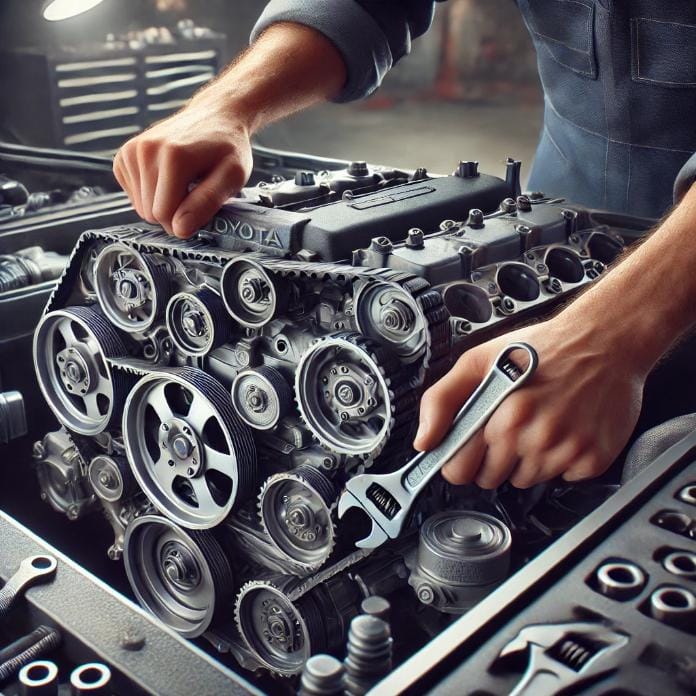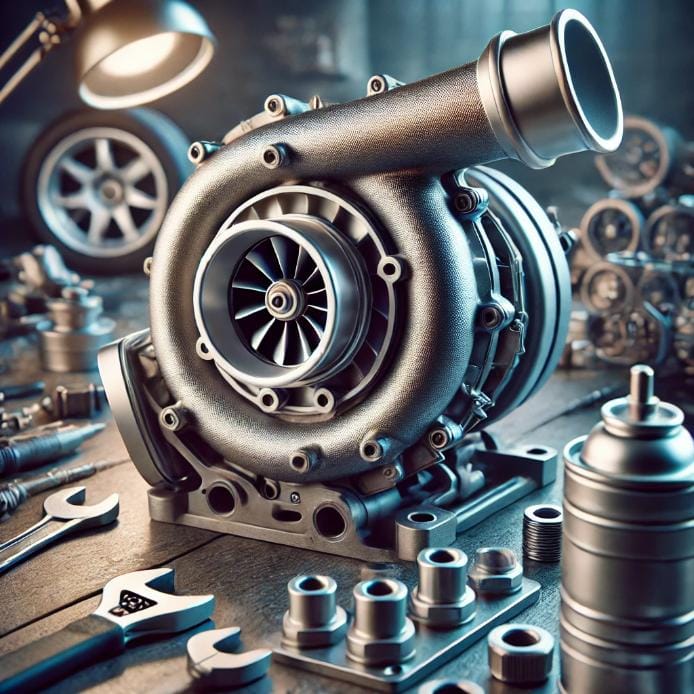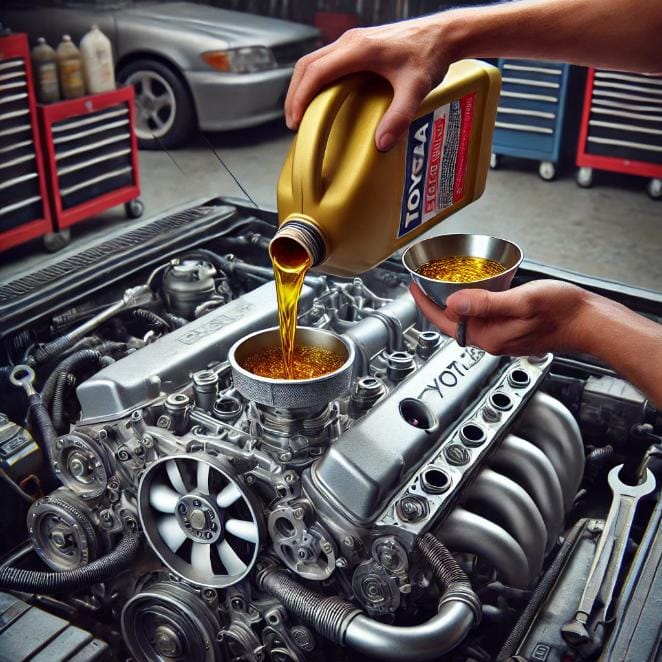The Toyota 2JZ engine is legendary among car enthusiasts and tuners worldwide. Revered for its bulletproof reliability, high power potential, and aftermarket support, the 2JZ is widely considered one of the greatest inline-6 engines ever built. Whether you own a naturally aspirated 2JZ-GE or a turbocharged 2JZ-GTE, maintaining these engines properly is key to ensuring they last for hundreds of thousands of miles.
However, despite its legendary status, the 2JZ is not without its flaws. Like any engine, it has weak points that can lead to performance issues, reliability concerns, and expensive repairs if not addressed early. Oil leaks, overheating, ignition problems, turbocharger failures, and timing belt wear are just a few of the most common issues 2JZ owners face.
Why Understanding 2JZ Engine Problems is Crucial 🔧
🚨 Ignoring minor issues can lead to catastrophic engine failure – A small oil leak might seem harmless, but if it leads to low oil pressure, it can destroy your turbo or rod bearings.
💰 Proactive maintenance is much cheaper than repairs – Fixing cooling system issues early can prevent a blown head gasket, saving you thousands of dollars.
🏁 Maximizing performance while maintaining reliability – Whether you’re running a stock engine or pushing 800+ HP on a built 2JZ, understanding its weak points ensures you get the most out of it without compromising longevity.
What You Will Learn in This Guide 📖
✔ Comprehensive List of 2JZ Problems – From common oil leaks to turbo failures.
✔ Step-by-Step Fixes for Each Issue – DIY repairs vs. professional service recommendations.
✔ Best Upgrades & Preventative Measures – Keep your 2JZ reliable while increasing performance.
✔ Real-World Solutions from 2JZ Owners & Mechanics – Avoid common mistakes and save money.
By following this guide, you will be able to diagnose, fix, and prevent the most common 2JZ engine problems, ensuring your engine stays strong for years to come.

Understanding the 2JZ Engine – Strengths & Weaknesses
Before diving into common 2JZ engine problems, it’s important to understand the design, strengths, and potential weaknesses of this legendary inline-6 powerplant.
Toyota 2JZ Engine Variants 🔍
The 2JZ engine family comes in two primary versions:
🔹 2JZ-GE (Naturally Aspirated)
📍 Found in: Lexus GS300, IS300, SC300, Toyota Crown, Toyota Aristo
💡 Key Features:
- No turbocharger, meaning simpler maintenance and fewer components to fail.
- Higher compression ratio (9.6:1) compared to the turbo model.
- Uses softer valve springs and different cam profiles than the GTE model.
- Excellent for daily driving and reliability, but limited in stock performance.
🔹 2JZ-GTE (Turbocharged Performance Monster)
📍 Found in: Toyota Supra MK4, Aristo V300
💡 Key Features:
- Twin-sequential turbochargers (JDM models) or single turbo (USDM Supra).
- Lower compression ratio (8.5:1) to handle higher boost pressures safely.
- Stronger internals, including forged connecting rods and oil squirters for improved lubrication.
- Ideal for high-horsepower builds, capable of 800+ HP on stock internals with the right tuning.
📢 Fun Fact: Both GE and GTE blocks are nearly identical, but the GTE has a better flowing cylinder head and piston oil squirters, making it better suited for forced induction.
Strengths of the 2JZ Engine 🏆
The 2JZ is one of the most robust and well-engineered inline-6 engines ever made. Its design gives it several key advantages over other engines:
✅ Iron Block Construction – Unlike many aluminum engines, the cast-iron block makes the 2JZ extremely durable, capable of withstanding high horsepower levels.
✅ Non-Interference Design – If the timing belt snaps, the pistons won’t collide with the valves, preventing catastrophic engine failure.
✅ High-Flow Cylinder Head – The GTE variant has one of the best flowing cylinder heads in its class, making it highly efficient at high RPMs and boost levels.
✅ Strong Factory Internals – The stock pistons, rods, and crankshaft can handle up to 800HP+, making it a dream engine for tuners.
✅ Aftermarket Support – Because of its legendary status, there are countless aftermarket parts available, from big turbos to standalone ECUs, allowing for limitless tuning potential.
Common Weak Points of the 2JZ Engine 🚨
Despite its bulletproof reputation, no engine is 100% perfect. Over time, certain weak points can develop, especially as mileage increases or power is pushed beyond factory limits.
⚠️ Weak Point #1: Oil Leaks (Valve Cover, Cam Seals, and Main Seals)
- The valve cover gaskets and cam seals harden over time, leading to seepage and leaks.
- The rear main seal is another common source of oil loss, often requiring transmission removal for replacement.
⚠️ Weak Point #2: Overheating & Cooling System Failures
- Stock radiators tend to crack with age, especially under high-boost conditions.
- The factory water pump and thermostat can fail over time, leading to overheating.
⚠️ Weak Point #3: Ignition System Wear (Coil Packs & Spark Plugs)
- Coil packs degrade over time, leading to misfires and rough idling.
- Incorrect spark plug heat range can cause detonation, potentially damaging the pistons.
⚠️ Weak Point #4: Turbocharger Wear & Shaft Play (2JZ-GTE)
- The stock twin turbos on JDM 2JZ-GTE models are ceramic-based and prone to failure under high boost.
- Turbo oil seals can leak, leading to oil consumption and blue exhaust smoke.
⚠️ Weak Point #5: Timing Belt Wear & Tensioner Issues
- Although the 2JZ is a non-interference engine, a snapped timing belt can still leave you stranded.
- Factory hydraulic tensioners can wear out, leading to belt slippage.
⚠️ Weak Point #6: VVT-i System Issues (Late-Model 2JZ-GE & 2JZ-GTE)
- Oil control valve failures can cause rough idle and power loss.
- Sludge buildup in VVT-i solenoids can restrict oil flow, affecting valve timing efficiency.
Why Understanding These Weaknesses Matters
By knowing where common failures happen, you can stay ahead of potential issues and avoid costly breakdowns. Whether your 2JZ is a daily driver, weekend warrior, or track monster, proactive maintenance of these components ensures maximum reliability and longevity.

Common 2JZ Engine Problems & How to Fix Them 🔧
Even though the 2JZ engine is known for its durability and performance, it still has its fair share of common problems. Whether you have a 2JZ-GE (Naturally Aspirated) or a 2JZ-GTE (Turbocharged), certain issues are more frequent than others due to wear and tear, aging components, or improper maintenance.
This section will break down each issue, explaining:
- Causes ⚠️
- Symptoms 🚨
- Diagnosis Methods 🔍
- Step-by-Step Fixes & Upgrades 🛠️
Oil Leaks & Low Oil Pressure Issues 🛢️
🚨 Symptoms of Oil Leaks in a 2JZ Engine
✔ Oil spots under the car after parking.
✔ Burning oil smell inside the cabin.
✔ Low oil levels between oil changes.
✔ Blue or white smoke from the exhaust (if severe).
⚠️ Common Leak Points & Causes
| Leak Source | Cause |
| Valve Cover Gaskets | Rubber seals dry out & crack with heat cycles. |
| Camshaft Seals | Age-related wear or incorrect installation. |
| Front & Rear Main Seals | High-mileage wear, excessive crankcase pressure. |
| Turbo Oil Lines (2JZ-GTE Only) | Oil feed/return lines degrade over time. |
| Oil Pan Gasket | Gasket failure due to pressure & vibrations. |
🛠️ How to Fix 2JZ Oil Leaks
✔ Step 1: Identify the leak location with a UV dye test or visual inspection.
✔ Step 2: Replace valve cover gaskets (OEM Toyota recommended).
✔ Step 3: Use FIPG (Form-In-Place Gasket) sealant on corners for extra protection.
✔ Step 4: If the leak is at the camshaft or crankshaft seals, remove timing components and replace the worn seals.
✔ Step 5: Check for excessive crankcase pressure (blocked PCV valve).
🚨 Pro Tip: Upgrade to a baffled oil catch can to reduce crankcase pressure and prevent future leaks.
Overheating & Cooling System Failures 🌡️
🚨 Symptoms of Overheating in a 2JZ Engine
✔ Temperature gauge rising above normal.
✔ Coolant overflow or leaks around radiator.
✔ White steam from the engine bay.
✔ Coolant boiling inside the reservoir.
⚠️ Common Causes of Overheating
| Cause | Impact |
| Clogged Radiator | Poor coolant circulation, heat buildup. |
| Failing Water Pump | Coolant not circulating properly. |
| Faulty Thermostat | Stuck closed = overheating, stuck open = overcooling. |
| Leaking Hoses or Cracked Radiator | Coolant loss = reduced heat dissipation. |
| Bad Cooling Fans or Fan Clutch | Insufficient airflow = engine runs hotter. |
🛠️ How to Fix 2JZ Overheating
✔ Step 1: Check coolant levels and inspect for leaks.
✔ Step 2: Perform a coolant flush every 30,000 miles with Toyota Red Long-Life Coolant.
✔ Step 3: Replace old rubber hoses and check for cracks.
✔ Step 4: Upgrade to an aluminum radiator (Mishimoto, Koyo, CSF).
✔ Step 5: Replace the thermostat with a TRD 160°F low-temp thermostat.
✔ Step 6: If using an electric fan setup, ensure it’s operating at full efficiency.
🚨 Pro Tip: Install a larger capacity oil cooler to reduce overall engine temperatures for track or high-performance builds.
Valve Stem Seal Wear & Oil Burning Issues 🔥
🚨 Symptoms of Worn Valve Stem Seals
✔ Blue smoke on startup.
✔ Increased oil consumption.
✔ Rough idle due to oil contamination in combustion chambers.
⚠️ What Causes Valve Stem Seal Wear?
❌ High mileage wear (rubber hardens and cracks over time).
❌ Low-quality oil or lack of regular oil changes.
❌ Extended periods of aggressive driving without proper maintenance.
🛠️ How to Fix 2JZ Valve Stem Seal Issues
✔ Step 1: Confirm issue with compression & leak-down tests.
✔ Step 2: Replace valve stem seals using OEM Toyota or Viton aftermarket seals.
✔ Step 3: Upgrade to higher-quality engine oil with detergents that prevent seal degradation.
🚨 Pro Tip: If your engine is burning excessive oil, a full cylinder head rebuild may be necessary.
Timing Belt Wear & Failure ⏳⚙️
🚨 Symptoms of a Worn Timing Belt
✔ Loud ticking noise from timing cover.
✔ Slight misfiring or rough idling.
✔ Engine hesitation or power loss.
✔ Belt looks cracked or frayed.
⚠️ Why the Timing Belt is Critical
- The 2JZ engine is a non-interference engine, meaning a snapped timing belt won’t destroy pistons or valves. However, it WILL leave you stranded if it fails.
- Recommended replacement interval: Every 90,000 miles.
🛠️ How to Replace a 2JZ Timing Belt
✔ Step 1: Remove fan, pulleys, and timing cover.
✔ Step 2: Align crankshaft & camshaft timing marks.
✔ Step 3: Remove the old belt and inspect tensioner.
✔ Step 4: Install new timing belt (OEM or Gates Racing belt recommended).
✔ Step 5: Rotate crankshaft two full revolutions to verify timing.
🚨 Pro Tip: Always replace the water pump and hydraulic tensioner when replacing the timing belt.
Ignition Coil & Spark Plug Issues 🔥
🚨 Symptoms of Ignition Failure
✔ Misfires under acceleration.
✔ Check Engine Light (P0300, P0301-P0306 codes).
✔ Loss of fuel economy.
⚠️ Common Causes
| Issue | Solution |
| Old or weak coil packs | Upgrade to OEM Toyota or R8 coil packs. |
| Worn-out spark plugs | Use NGK Iridium or Denso Iridium plugs. |
| Bad ignition wires | Replace with high-performance wires. |
🛠️ How to Fix Ignition Problems in a 2JZ
✔ Step 1: Scan for codes using an OBD-II reader.
✔ Step 2: Replace failing coil packs or spark plugs.
✔ Step 3: Ensure correct plug gap for turbo setups.
🚨 Pro Tip: Running colder spark plugs on a turbocharged engine helps prevent detonation.

Turbocharger Problems & Boost Leaks (2JZ-GTE Only) 🌀💨
The 2JZ-GTE turbo system is one of the most iconic aspects of this engine. While it’s capable of producing massive horsepower gains, it also requires proper maintenance to avoid turbo failure, oil leaks, and boost leaks.
🚨 Symptoms of Turbocharger Issues
✔ Loss of boost pressure or slower spool time.
✔ Excessive smoke from the exhaust (blue or white).
✔ Whining or siren-like noise from the turbo.
✔ Oil consumption increases significantly.
✔ Boost gauge shows inconsistent or erratic readings.
⚠️ Common Turbo Issues & Their Causes
| Issue | Cause |
| Turbo Shaft Play | Worn bearings due to age or poor lubrication. |
| Oil Seal Failure | High crankcase pressure, excessive boost, or bad oil feed. |
| Boost Leaks | Cracked vacuum hoses, loose clamps, or leaking intercooler. |
| Wastegate Malfunction | Failing actuator spring or boost control issues. |
| Compressor Surge (Flutter Sound) | Poor tuning or incorrect blow-off valve setup. |
How to Fix Turbocharger Problems in a 2JZ-GTE
✔ Step 1: Check for Shaft Play – Remove the intake pipe and check for side-to-side or in-out movement in the turbo shaft.
✔ Step 2: Inspect for Oil Leaks – Check the turbo drain and feed lines for leaks.
✔ Step 3: Perform a Boost Leak Test – Pressurize the intercooler system to identify leaks in hoses or clamps.
✔ Step 4: Verify Wastegate & Blow-Off Valve (BOV) Function – A malfunctioning wastegate can cause boost spikes that damage the engine.
✔ Step 5: Upgrade to a Single Turbo (If Needed) – If the factory twin turbos are failing, a single turbo conversion (Garrett, BorgWarner, Precision) can provide better reliability and power control.
🚨 Pro Tip: If pushing more than 18 PSI, upgrade to steel turbo wheels (instead of ceramic JDM turbos) to prevent turbo failure.
VVT-i System Malfunctions (2JZ-GE & 2JZ-GTE Late Models) ⚙️
In later versions of the 2JZ-GE and 2JZ-GTE, Toyota introduced VVT-i (Variable Valve Timing with intelligence) to improve fuel efficiency and low-end torque. However, the VVT-i system is prone to failure, causing rough idle, power loss, and sluggish acceleration.
🚨 Symptoms of VVT-i Failure
✔ Loss of power at low RPMs.
✔ Check Engine Light (VVT System Malfunction Code: P1349).
✔ Rough idle or hesitation when accelerating.
✔ Engine feels “lazy” and doesn’t rev as smoothly.
⚠️ Common VVT-i Issues & Causes
| Issue | Cause |
| Bad VVT-i Solenoid | Clogged or stuck solenoid, restricting oil flow. |
| Sludge Buildup in VVT-i Actuator | Old or dirty oil causing blockages. |
| Low Oil Pressure | Affects the ability of VVT to adjust timing. |
| Faulty VVT-i Control Valve | Causes incorrect camshaft adjustments. |
🛠️ How to Fix VVT-i System Malfunctions
✔ Step 1: Scan for OBD-II Codes – If P1349 (VVT System Malfunction) appears, there is an issue with the solenoid or oil control.
✔ Step 2: Check Oil Quality & Level – Old or low oil can starve the VVT-i system, preventing it from working correctly.
✔ Step 3: Replace the VVT-i Solenoid – If the solenoid is clogged or faulty, a new OEM Toyota VVT-i solenoid should be installed.
✔ Step 4: Clean the VVT-i Actuator – Remove the actuator and clean any oil sludge buildup.
✔ Step 5: Ensure Proper Oil Flow – Using 5W-40 full synthetic oil prevents sludge buildup in the VVT-i system.
🚨 Pro Tip: If VVT-i issues persist, a standalone ECU tune (Haltech, MoTeC, Link ECU) can help optimize timing adjustments.
Fuel System Issues & Fuel Pump Failures ⛽
The 2JZ fuel system is robust, but old fuel pumps, injectors, and filters can cause misfires, hesitation, and lean conditions.
🚨 Symptoms of Fuel System Problems
✔ Hesitation or bogging under acceleration.
✔ Engine runs lean (higher-than-normal AFR readings).
✔ Fuel pressure drops under boost (for turbo models).
✔ Car struggles to start or stalls frequently.
⚠️ Common Fuel System Issues & Causes
| Issue | Cause |
| Fuel Injector Clogs | Old fuel, debris, or carbon buildup. |
| Weak Fuel Pump | Failing over time or insufficient for high boost. |
| Bad Fuel Pressure Regulator | Causes inconsistent fuel delivery. |
| Clogged Fuel Filter | Restricts flow, leading to misfires. |
🛠️ How to Fix 2JZ Fuel System Problems
✔ Step 1: Perform a Fuel Pressure Test – Use a fuel pressure gauge to check if pressure is too low under acceleration.
✔ Step 2: Replace the Fuel Pump – Upgrade to a Walbro 450LPH, AEM 340LPH, or Bosch 044 pump if running more power.
✔ Step 3: Clean or Replace Fuel Injectors – Ultrasonic injector cleaning removes debris and carbon buildup.
✔ Step 4: Change the Fuel Filter – Replace every 50,000 miles to prevent pressure drops.
🚨 Pro Tip: If running E85 fuel, make sure you upgrade to high-flow injectors & ethanol-compatible fuel lines.

Preventative Maintenance for Long-Lasting 2JZ Reliability 🛡️
✅ Key Maintenance Intervals for 2JZ Owners
| Component | Maintenance Interval |
| Oil Change (Full Synthetic) | Every 3,000-5,000 miles |
| Coolant Flush | Every 30,000 miles |
| Timing Belt & Water Pump | Every 90,000 miles |
| Valve Stem Seal Check | Every 100,000 miles |
| Ignition Coil & Spark Plug Replacement | Every 40,000 miles |
| Turbo Inspection (2JZ-GTE) | Every 10,000 miles |
| Fuel System Cleaning | Every 50,000 miles |
🚨 Pro Tip: Stick to OEM Toyota parts or high-quality aftermarket brands (HKS, Greddy, Tomei, etc.) to maintain reliability.
Final Thoughts
Keeping Your 2JZ Reliable for Years
Even though the Toyota 2JZ engine is one of the most reliable inline-6 engines ever built, common issues arise over time, especially if maintenance is neglected. Here’s what you need to remember:
🔥 Key Takeaways for 2JZ Longevity
✅ Regular Oil Changes Are a Must – Using high-quality synthetic oil (5W-40 or 10W-50) prevents sludge buildup and protects turbo seals.
✅ Keep the Cooling System Healthy – Flushing the coolant every 30,000 miles and upgrading the radiator prevents overheating-related damage.
✅ Check for Oil Leaks Frequently – Valve cover gaskets, cam seals, and turbo oil lines are common failure points.
✅ Replace Ignition Components Before They Fail – Upgrading to OEM or R8 coil packs ensures a strong spark and consistent power.
✅ Monitor Your Turbo’s Health (2JZ-GTE Owners) – Check for shaft play and boost leaks to prevent premature failure.
✅ Prevent VVT-i Failures – Keep VVT-i solenoids clean and change oil regularly to avoid cam timing issues.
Frequently Asked Questions (FAQs)
What are the most common 2JZ engine problems and their fixes?
The Toyota 2JZ engine is one of the most reliable inline-6 engines ever built, but over time, certain issues can arise. Here are the top problems and their solutions:
| Problem | Cause | Fix |
| Oil Leaks | Valve cover gaskets & cam seals dry out. | Replace gaskets with OEM Toyota parts. |
| Overheating | Failing water pump, thermostat, or radiator. | Upgrade to an aluminum radiator & replace the thermostat. |
| Turbocharger Failure (2JZ-GTE) | Worn seals, shaft play, boost leaks. | Check turbo for shaft play, replace worn seals, upgrade to a ball-bearing turbo. |
| Ignition Coil & Spark Plug Issues | Aging coil packs cause misfires. | Upgrade to OEM or R8 coil packs, use NGK Iridium spark plugs. |
| VVT-i System Malfunction | Clogged oil control valve & solenoid failure. | Clean or replace VVT-i solenoid, ensure proper oil pressure. |
How do I fix overheating issues in my 2JZ engine?
Overheating is a common issue in high-performance engines like the 2JZ. If your temperature gauge is rising too high, follow these steps:
✔ Step 1: Check Coolant Levels – Ensure coolant is at the correct level and there are no leaks.
✔ Step 2: Inspect Radiator & Hoses – Cracked or old radiators/hose leaks reduce cooling efficiency.
✔ Step 3: Flush & Refill Coolant Every 30,000 Miles – Use Toyota Red Long-Life Coolant.
✔ Step 4: Replace the Thermostat with a TRD 160°F Unit – Helps keep temperatures lower.
✔ Step 5: Upgrade to an Aluminum Radiator (Mishimoto, Koyo, CSF) – Prevents overheating under boost.
✔ Step 6: Ensure Cooling Fans Are Functioning – Faulty fans can cause the engine to run hotter.
🚨 Pro Tip: Installing a high-flow oil cooler can significantly lower overall engine temperatures.
How long does a 2JZ engine last with proper maintenance?
With proper care and maintenance, a 2JZ engine can last 500,000+ miles before needing a rebuild. Key maintenance tips for longevity include:
✅ Oil Changes Every 3,000-5,000 Miles – Use full synthetic oil (5W-40 or 10W-50) to prevent sludge buildup.
✅ Timing Belt & Water Pump Replacement Every 90,000 Miles – Prevents catastrophic failure.
✅ Coolant System Flush Every 30,000 Miles – Prevents overheating & head gasket issues.
✅ Regular Turbo Inspections (2JZ-GTE) – Check for shaft play, oil leaks, and boost leaks.
✅ Fuel System Maintenance Every 50,000 Miles – Replace fuel pump, clean injectors, and swap fuel filter.
💡 Fun Fact: Many 2JZ engines have crossed 300,000 miles with just routine maintenance!
What is the best oil for a 2JZ engine?
Using high-quality synthetic oil is critical to keeping your 2JZ engine running smoothly and preventing wear. The best oil depends on your driving style and modifications:
| Engine Setup | Recommended Oil | Reason |
| Stock 2JZ-GE (Daily Driver) | 5W-30 Full Synthetic | OEM Toyota-recommended oil for smooth operation. |
| Stock 2JZ-GTE (Turbocharged) | 5W-40 Full Synthetic (Motul, Red Line) | Provides better heat resistance for turbo setups. |
| Modified High-Boost 2JZ-GTE | 10W-50 (Liqui Moly, HKS Racing Oil) | Protects against high-temperature wear. |
| Track or Race Builds | 15W-50 (Motul, Amsoil) | Extra viscosity for extreme conditions. |
🚨 Pro Tip: Always use high-zinc (ZDDP) content oil for better cam and valvetrain protection.
How can I extend the lifespan of my 2JZ turbocharger?
Turbochargers in the 2JZ-GTE are powerful, but without proper maintenance, they wear out quickly. Here’s how to extend turbo life:
✔ Use High-Quality Synthetic Oil – Poor lubrication is the #1 cause of turbo failure.
✔ Let the Turbo Cool Down Before Shutting Off – Use a turbo timer or idle the car for 30-60 seconds.
✔ Check for Boost Leaks – A small leak forces the turbo to work harder, reducing lifespan.
✔ Replace Turbo Oil Lines Every 50,000 Miles – Clogged lines restrict oil flow, leading to premature failure.
✔ Upgrade to a Ball-Bearing Turbo – These last longer and spool faster than factory journal-bearing turbos.
🚨 Pro Tip: If running higher boost (18+ PSI), swap to steel-bladed aftermarket turbos (Garrett, BorgWarner, Precision) since the OEM ceramic JDM turbos are prone to failure.